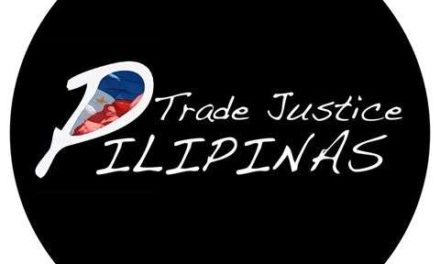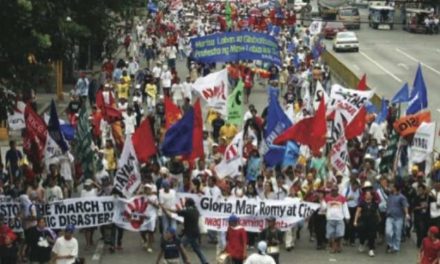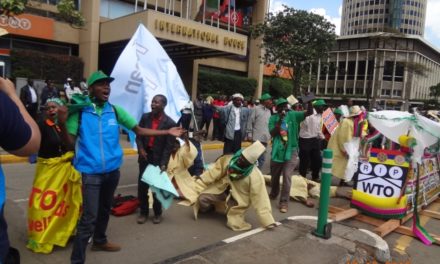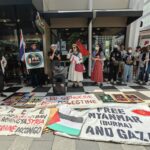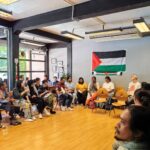By Aileen Kwa*
More Green Rooms
The main WTO negotiations carried out these days in Geneva, convened by the Chairman of the General Council, are held amongst only a very small group of about 30 delegations. This includes the all-important issue of agriculture. Many delegations in Geneva which have been totally marginalized from the process have privately expressed their anger regarding their exclusion, particularly as they recognize that the direction in which the talks are now proceeding are not taking their interests into account.
Whilst the co-ordinators of groups have been invited to the consultations – eg. The leaders of the G20, as well as the African Group co-coordinator, with presumably the understanding that these consultations will then be reported back to the groups, Members of the WTO have not relinquished their negotiating rights to their group co-ordinators. There is therefore much simmering disquiet. As one Caribbean negotiator informally commented: ‘We have been excluded from all the consultations post-Cancun. The process also has to be inclusive. How else are we going to ensure that our concerns are taken on board?’
EC/US / Derbez Texts: APEC Baptises the Derbez Text
The US and EC have been reported to be rather silent in the negotiations, and only rehashing the positions they had taken pre-Cancun, as reflected in their US/EC joint position paper (of Aug 13 2003). Developing country members have been instructed by the majors in the capital, by the IMF and World Bank chiefs, as well as by the traveling Director General to take the talks forward and to show flexibility. Yet the same flexibility is clearly not forthcoming from the US and EC.
Post-Cancun, the negotiations have in fact moved slightly closer to the US/EC position. APEC Members in October met and agreed that they would build upon the Derbez text in talks in Geneva. The Derbez text (of 13 September 2003), delivered in Cancun by the Mexican Minister Derbez, is essentially only a slight modification of the US/EC (13 August 2003) text.
The US/EC text introduced the ‘blended formula’, which takes into account the EC’s wish to protect their markets with high tariffs in their most sensitive sectors (eg. meat, diary, cereals). In exchange, it protects the US’ need to maintain high ‘trade-distorting’ (AMS and blue box) domestic supports to accommodate the additional billions offered in the US’ farm bill. It also conveniently allows both US and EC to ‘box-shift’ and continue high subsidies in the supposedly non-trade distorting ‘Green Box’.** And importantly, it enforces steep tariff cuts on developing countries – to meet both US/EC interests.
In Geneva, after the collapse of Cancun, there was no consensus over which text would be used for further negotiations. The presumption was that the various texts on the table – US/EC, Derbez, Harbinson, G20 and other submissions would be used.
However, APEC Ministers meeting in Thailand in October blessed the Derbez text – stating that negotiations should build upon it. Overnight, and as the major powers contacted other non-APEC Members, the tide also changed in Geneva. In particular, the Chairman of the General Council has been holding all his consultations based on this text alone.
Derbez Agriculture ‘Framework’: The Hidden Numbers Game
The framework approach, as opposed to negotiating ‘modalities’ mandated by the Doha Development Agenda, implies that general formulas with very few, if any numbers or details will be agreed upon. It also contains inadequate detail on domestic supports and export subsidies. This lack of clarity is disturbing since developing countries will be urged to accept a document that will only show its real impact in the second round of “modalities” negotiations.
However, as some negotiators have noted, the numbers have already been calculated by the US and EC, who know exactly what the implications of the general formula will be. It is only the developing country delegations that have been kept in the dark.
Some developing country delegations have undertaken some number crunching exercises with this framework. They found that when numbers are inserted, and the tariff reduction formula applied similarly to the developed and developing countries, developed countries will undertake only small amounts of market opening, whilst developing countries will have to bear up to two or three times more market opening. That is, agreeing to this framework will lock developing countries into a future negotiating context in which it will be near impossible to establish balanced results.
Most countries, cowed by the political pressures and the blame game, have accepted the text as the basis of negotiations, but have added a long list of caveats to what they want to see modified. Some countries such as India and Brazil have very effectively voiced their need for further clarification and numbers to be included in the Derbez text in agriculture. They have argued that only with more clarity can decisions be taken in these negotiations.
Market Access: The Blended Approach on Tariff Reductions
The blended approach on tariff reductions in the Derbez text calls upon Members to reduce tariffs under three different categories: tariff lines to be cut by an average overall percentage; tariff lines to be reduced under a Swiss formula (where the higher the tariffs, the higher the percentage cuts); and some tariffs to be reduced to zero or near zero. Developed and developing country Members, according to the text, are to liberalise according to this same formula, albeit with slightly different numbers.
However, because the tariff schedules of developed and developing countries are very different, the application of the same approach towards tariff reductions produces very different results. Whereas developed countries with some very high and mostly lower tariffs are likely to undertake only small tariff cuts, developing countries, with a more uniform tariff structure are likely to be forced to apply steep tariff cuts (a harmonizing effect). Only extreme figures applied to the developed countries – an unlikely outcome in the negotiations – could avert such unequal results.
Domestic Supports
The Derbez framework is a big step backwards in terms of disciplining domestic support in the developed countries. Commitments on trade distorting support could be made within a range, allowing the large subsidizers to strategically decide the level of reduction they would like to undertake to minimize the impact of reform. Moreover, as was the case in the Uruguay Round, reduction of support would take place from an aggregate measure of support instead of on a product-specific basis. This would allow for the continued provision of significant amounts of support to specific commodities.
In addition, a new category of support has been created by relaxing the provisions on the blue box with the sole purpose of accommodating the needs of increased trade-distorting support provided by countries like the US. Currently, the green box is made up of supposedly non or minimally trade distorting supports, and where direct payments can be provided without limits. OECD studies have already shown that even these supports in large amounts are distorting. Much ‘box-shifting’ – from the Amber or trade-distorting supports and the blue box to the green – is expected to take place. To avoid this box-shifting, which could easily nullify the cuts in support in the trade distorting and blue boxes, the green box should be capped at a certain level as a percentage of the value of total agricultural production. However, the Derbez framework only calls for a review of the criteria. The outcome of this review is impossible to predict, and would depend on countries’ political clout. The current framework approach clearly sets out to legitimize subsidies to agriculture!
Export Competition
Instead of insisting on the complete elimination of all forms of export subsidization as alluded to in the Doha mandate, there is currently no assurance in the Derbez text that this will be the case. The EC’s post-Cancun statements on this issue also does not inspire confidence. The EC /US position, that there will be elimination of export subsidies on products of interest to the developing countries is also misleading. The key products where EC provides subsidies are dairy, sugar and meat. If this framework without details is agreed to, it is not likely that developing countries in the ‘modalities’ phase will be able to argue for the elimination of export subsidies where it actually matters.
Derbez Text Reinforces Existing Inequities in Agricultural Trade:
Special and Differential Treatment for Developed Countries
The Derbez text essentially reinforces the existing structural inequities of agricultural trade. The distortions within the world market will only worsen. Not only will developing countries loose out in exports, but more importantly, since agriculture remains the main source of employment in the developing world, dumping will wipe out the only source of livelihood for millions of small farmers. This structural inequity is the real Special and Differential Treatment provided to developed countries! Any Special and Differential Treatment provisions, for instance, as provided in the Derbez text for developing countries, within this larger distorted agricultural trade environment, is merely cosmetic.
Weak G20 Agriculture Position
Whilst the G20, led by Brazil, India, China and South Africa, is an excellent political counterweight to the US/EC, and in that sense should be supported, its agriculture position begs improvement.
The G20 is strongest and most united and insistent on the issue of export subsidies and an end date for its complete elimination. Its position on domestic supports, however, is rather weak. Export subsidies, it must be remembered, when reduced, can also be conveniently shifted into the domestic supports programmes (as in EU cereals ‘reforms’ over the past decade). And instead of calling for a cap on overall domestic supports (AMS ie trade distorting support + de minimis + Blue Box + Green Box), the G20 is soft on the Green Box, and is only asking for a review of the Green Box criteria. More box-shifting, by both the US (to fit in the additional Farm Bill billions) and the EC (to accommodate the direct payment programmes endorsed by the recent CAP reform) will take place. Mexico seems to be one of the few countries still insisting on Green Box capping. The position which many developing countries had taken before – on the need to eliminate the Blue Box -seems also to have been fallen by the wayside. There is a resignation that even this enlarged Blue Box can remain in existence, although below 5% of the value of production. The distortions in agricultural trade will therefore not be radically changed with G20 demands.
On market access, India, backed strongly by Brazil is pushing for a Uruguay Round formula for tariff cuts. Whilst this will be less drastic than the Swiss formula or blended formula in the Derbez text, many developing countries nevertheless will be hurt by further cuts. There are few other members, however, who are advocating a better position in the current negotiations.
Alliance on SP and SSM
The Alliance on Strategic Products (SP) and Special Safeguard Mechanism (SSM) grouping have called for the protection of tariffs on some products for food security and rural livelihood reasons. However, the developed countries seem to have inferred to them that the SP will be granted them (in a very diluted form, and tariff cuts are still required) if these countries agree to the blended formula in the Derbez text. This is a position that remains unacceptable to this Alliance.
Wherefore Negotiations: Towards 15 December and Beyond
Most members are not expecting any dramatic decisions on 15 December (the Senior Officials meeting that was set in Cancun), particularly as the EC would barely have completed their internal consultations. At the time of writing, even the mandate on whether or not there should be an end date for export subsidies is yet to be decided. The EC is also not expected to send any high level official to this meeting.
However, some kind of a roadmap will most likely be provided by the Chair of the General Council, Perez del Castillo, come 15 December date, if only to keep up appearances to the outside world that the WTO has gone back to business. This roadmap is expected to be light on details if a small-scale Cancun-style collapse is to be averted.
However, trade delegates are unsure what del Castillo’s decisions in agriculture may be. Even a loose roadmap which calls for negotiations to be based on the framework approach and the Derbez text: including the blended tariff formula; the enlarged blue box; the aggregated reduction in the AMS; and no provision on any Green Box cap; would already lock the parameters of the negotiations in, in ways that would be detrimental for the developing world.
*Article written with contributions from Alexandra Strickner of IATP.
** Most technical terms used in this article are explained in ‘Guide to the Agreement on Agriculture: Technicalities and Trade Tricks Explained’, 1998.
http://www.focusweb.org/publications/1998/AOA.pdf

